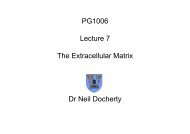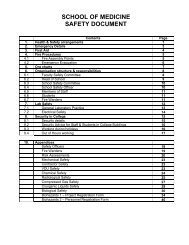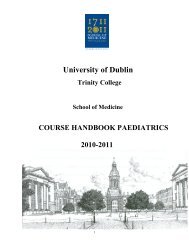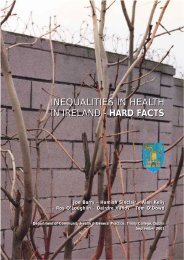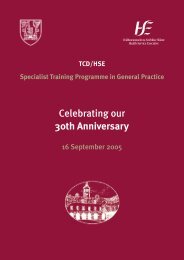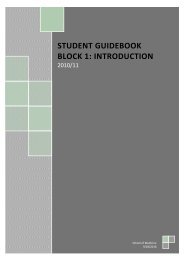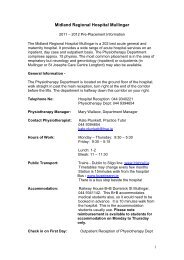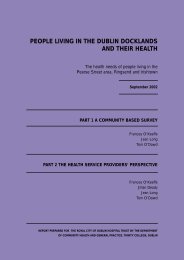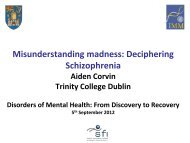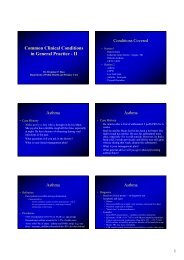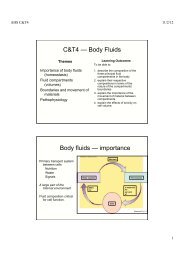year-2-study-guide-2.. - School of Medicine - Trinity College Dublin
year-2-study-guide-2.. - School of Medicine - Trinity College Dublin
year-2-study-guide-2.. - School of Medicine - Trinity College Dublin
Create successful ePaper yourself
Turn your PDF publications into a flip-book with our unique Google optimized e-Paper software.
Metabolic diseases (4 lectures)<br />
Definition, current diagnostic criteria and classification <strong>of</strong> diabetes mellitus.<br />
Lecture 1: Introduction to diabetes mellitus (Nolan/Pazderska)<br />
pathophysiology and clinical and biochemical characteristics <strong>of</strong> type 1 and type 2<br />
diabetes mellitus. Epidemiological data regarding increasing prevalence and<br />
incidence <strong>of</strong> both main types <strong>of</strong> diabetes and obesity. Interplay between obesity,<br />
metabolic syndrome and type 2 diabetes. Stages <strong>of</strong> glucose intolerance and the main<br />
preventive strategies for developing diabetes in individuals at risk. Complications in<br />
patients with type 2 diabetes and how we can reduce their risk.<br />
Lecture 2: Cellular and molecular mechanism <strong>of</strong> diabetes mellitus (Nolan/<br />
Pazderska)<br />
Physiology <strong>of</strong> insulin secretion and its action at cellular level. Examples <strong>of</strong> monogenic<br />
forms <strong>of</strong> diabetes will be used to illustrate the effects <strong>of</strong> disrupting insulin secretion<br />
and action at various levels. Genetic background <strong>of</strong> type 1 and type 2 diabetes.<br />
Immune processes occurring in pathophysiology <strong>of</strong> type 1 diabetes and the role <strong>of</strong><br />
HLA antigens. Molecular mechanisms leading to the development <strong>of</strong> microvascular<br />
complications.<br />
Learning objectives:<br />
1. Define diabetes mellitus and discuss current classification and diagnostic<br />
criteria.<br />
<strong>2.</strong> Characterise the main differences between type 1 and 2 diabetes.<br />
3. Discuss genetic background and main differences in genetic susceptibility for<br />
type 1 and type 2 diabetes.<br />
4. Describe immune processes occurring in type 1 diabetes and the role <strong>of</strong> HLA<br />
antigens.<br />
5. Describe the interplay between obesity, insulin resistance and type 2 diabetes.<br />
References:<br />
1. "Definition, Diagnosis and Classification <strong>of</strong> Diabetes Mellitus and its<br />
Complications." Report <strong>of</strong> WHO Consultation. This is a link to where it can be<br />
downloaded: http://whqlibdoc.who.int/hq/1999/WHO_NCD_NCS_99.<strong>2.</strong>pdf<br />
<strong>2.</strong> www.easd.org<br />
3. www.diabetes.org<br />
3. The molecular genetics <strong>of</strong> type 1 diabetes:new genes and emerging mechanisms.<br />
Trends in Molecular <strong>Medicine</strong>; 2008 Jun; 14(6):268-75.Epub 2008 May 14.<br />
Lecture 3: Introduction to Obesity (Nolan/Wanic).<br />
We are going to discuss the definitions/measures, epidemiology, complications and<br />
treatment <strong>of</strong> obesity. We also will discuss the central regulation <strong>of</strong> calorie intake. We<br />
will mention co-morbidities associated with obesity. We will focus on neuroendocrine<br />
control <strong>of</strong> eating (the role <strong>of</strong> leptin etc.).<br />
19





